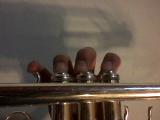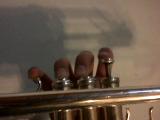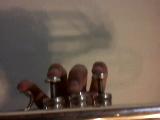These are the fingerings for a Bb trumpet. These fingerings are not restricted to the notes shown below. These fingering can be applied for pedal notes and for higher range notes for the same notes they are used for normally. The notes shown are where these fingerings are consistent.  The picture above shows an open fingering. This is used to play C (one ledger line below the staff), G (staff), C (staff), E (staff), G (above staff), C (two ledger lines above the staff).  The picture above shows the fingering of all the valves pressed. The only two notes that this fingering is primarily used for is F# or Gb (about three ledger lines below the staff) and C# or Db (about one ledger line below the staff). However, this fingering is an alternate for some other notes. This fingering should not be used primarily because it affects the tuning. The notes include F# or Gb (staff), C# or Db (staff), F# or Gb (top of staff).  The picture above shows the fingering of the 1st and 3rd valves. This is used primarily for G (about two ledger lines below the staff) and D (right below the staff). It is very important that the 3rd valve slide is pulled out with this fingering because this fingering usually results in sharp notes, especially for the D below the staff. Check how much you need to move the slide in order to be in tune. Also, this fingering can be used as an alternate fingering for G (staff), D (staff), G (top of staff).  The picture above shows the fingering of the 2nd and 3rd valves. This fingering is used primarily for G# or Ab (about two ledger lines below the staff), D# or Eb (below the staff), G# or Ab (staff), and a G# or Ab (about one ledger line above the staff). This fingering is also an alternate for C (staff) and D# or Eb (staff).  The picture above shows the fingering of the 1st and 2nd valves. This is used primarily for A (two ledger lines below the staff), E (bottom of staff), A (staff), C# or Db (staff), and A (one ledger line above the staff). This is also an alternate fingering for an E (top of staff).  The picture above shows the fingering of the 1st valve, which is a very common fingering. The first valve is used to play A# or Bb (about two ledger lines below the staff), F (bottom of staff), A# or Bb (staff), D (staff), F (top of staff), A# or Bb (about two ledger lines above the staff).  This is the last of the seven primary fingerings, which is the 2nd valve. The second valve is used to play B (about one ledger line below the staff), F# or Gb (bottom of staff), B (staff), D# or Eb (staff), F# or Gb (top of staff), and B (about one ledger line above the staff). WAIT A SECOND! YOU FORGOT ONE!  That's right! There's one more. However, this fingering, which is just the 3rd valve, is not used primarily for any note. It is basically an alternate fingering for the 1st and 2nd valve (shown below). The 3rd valve fingering is the equivalent of the the 1st and 2nd valve, which means it can be used for both the primarily and alternative notes for the fingering of the 1st and 2nd valve. It is not recommended to use the fingering above, but it should come useful in playing with trills or improvising in a solo.  |